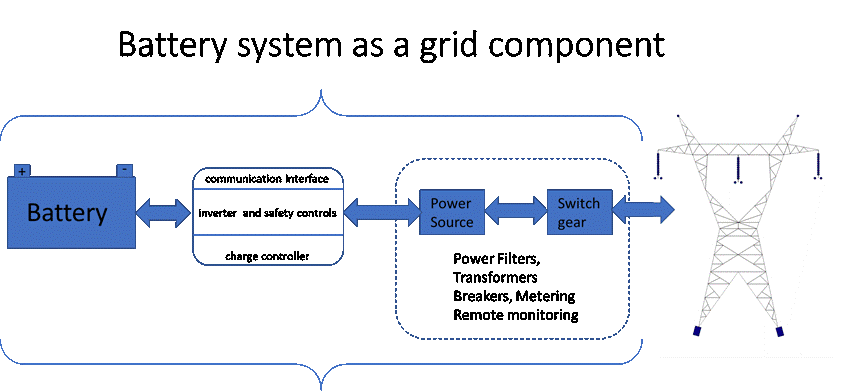

The theme of this blog is grid-scale batteries reduce generation, transmission, and distribution costs while improving grid reliability and resilience. One thing that has not changed is the demand for reliable power, since our lifestyle and economy depend on reliable electric power. Customers in developed countries demand even higher reliability, and existing customers (plus currently unserved potential customers) in the developing countries recognize that reliable electric power is essential for them to participate in a connected digital world. In all countries, various government organizations are charged with making the rules that keep electric grids reliable. What has changed are the options to achieve reliable electric power and the changing sources of new electric power generation. In developed countries, we see a shift from coal- or nuclear-fueled central station power generation to both natural gas generation and less costly, but intermittent wind and solar generation. In developing countries with lower electric power reliability, we see a priority on “resilience,” with individual customers building microgrids using distributed energy resources.
In the US, FERC requires that utilities and transmission system operators keep the grid operating at a high level of reliability and to achieve that reliability at the lowest cost. In the past, we have seen grid-scale batteries for many applications, but on February 15, 2018, the Federal Energy Regulatory Commission (FERC) voted for FERC rule 841 to remove the existing barriers to having electric storage resources participate in the capacity, energy and ancillary services markets operated by Regional Transmission Organizations (RTOs) and Independent System Operators (ISOs). According to FERC, this order will enhance competition and promote greater efficiency in the nation’s electric wholesale markets and help support the resilience of the bulk power system. This FERC order will open the door to grid-scale battery storage markets to a significant degree.
The DOE Grid Modernization Laboratory Consortium (GMLC) has identified more than 40 ancillary services that battery storage could provide in various situations. In some of these situations, batteries can switch operating modes to provide multiple services to provide even greater return on investment.
|
|
Ancillary Service |
Time scale |
Value |
|
1 |
Frequency Regulation |
Milliseconds to 1 hour |
Grid stability |
|
2 |
Peak Power, load shifting |
Up to 6 hours for peak, up to 16 hours for load |
Reduced generation and transmission capacity investments |
|
3 |
Transmission or Distribution Load Control |
Up to 4 hours |
Reduced transmission or distribution capacity investments |
|
4 |
Critical Power Island |
Hours - Days |
Resiliency for business, reduced utility investments, grid stability |
|
5 |
VAR Control |
Up to 4 hours |
Grid stability, transmission & distribution capacity |
|
6 |
Energy Cost Control |
Up to 4 hours |
Lower generation costs |
|
7 |
Renewable Integration |
Up to 4 to 24 hours |
Lower energy costs, lower emissions |
Batteries are now being packaged as standard grid components in modular containers that can be quickly installed without the complex siting requirements of pumped hydro or compressed air energy storage (CAES).

The business model of central station power is being disrupted by the demand for low-carbon energy and the costs of infrastructure to avoid nuclear power accidents. With the widescale deployment of wind and solar power generation, we have seen great improvements in the technology and renewable costs have reached grid parity with more conventional generation options. Europe has demonstrated that grid reliability can improve even with a high penetration of non-dispatchable renewables. As penetration of renewable generation increases, the loss of spinning reserves, makes battery-related ancillary services more valuable. While pumped hydro and CAES can provide grid-scale energy storage, they involve very restrictive siting and take a long time to engineer and build compared to battery energy storage, which appear to be a standard grid component, much like a transformer.
Driving forces for grid-scale batteries include:
Consider a few examples to see why grid-scale batteries make sense. A recent utility risk assessment required improved reliability to meet FERC requirements. The option was $10 million in switchgear or $4 million for a battery system that could make the same reliability improvement. Consider the rebuild of the Puerto Rican electrical grid. With a history of poor grid reliability, various hospitals, fire, police, cell towers, and businesses have invested in microgrids that include solar PV power and battery storage to provide resiliency and improved options for future hurricanes. These microgrids are designed to integrate with the new island grid system. Municipal electric plants have installed batteries to trim peak power. In another example, at the two MW microgrid battery installation in Sterling, Massachusetts the project savings in transmission and capacity costs alone will pay back the cost of the batteries in only a few years. It has been reported that the world’s largest battery, the 100 MW Tesla batter in Australia, saved over $1 million in only a few days by providing critical frequency control and by load shifting.

